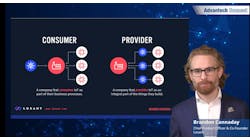Advantech, partners tackle climate challenges
“Large installations and massive scale are implicit and the network edge is still messy and complex. But Advantech and our partners can help to simplify that digital transformation journey.” Paul O’Shaughnessy (left) led a panel discussion exploring the particular IoT demands of energy and environmental solutions providers.
From global warming to pollution to availability of fresh water, issues of energy and the environment are on the critical path to society’s very survival. What’s missing today, despite continued investments by government around the world, is a sustainable operating model, said Chingpo Lin, associate vice president of Advantech’s Industrial-IoT Group, in kicking off the Sustainable Energy & Environment Operation & Maintenance program of the 2021 Advantech Connect Online Partner Conference.
“Sustainable operations is key, but also a huge challenge,” Lin said, describing what he sees as three primary initiatives that are critical to progress on the sustainability front. These include remote monitoring and control, predictive maintenance enabled by analytics, and optimization through intelligent operations. The success of these initiatives will turn on a handful of key enabling technologies, Lin added, including edge intelligence, cloud platforms for analysis and device management, and secure wireless communications including the latest 5G technologies and OPC UA.
On the wireless front, Advantech realizes that “it’s not a question of which is best but which is most suitable,” Lin continued. “Our approach is a modularized design so that you can pick the right solution.” Those choices include traditional operational technology protocols, but increasingly IT and cellular technologies are in play, including Wi-Fi, LoRaWAN, LPWAN, NB-IoT and LTE-M. Managing this diversity of networks—and securing those communications all the way from the device level to the cloud—are key challenges, Lin noted. Encryption, in particular, is addressed through the use of OPC UA and its certificate-based security model for even the lowest levels of automation communications. The company’s ADAM-6300 Series I/O modules, for example, communicate using OPC UA over Ethernet to “easily and securely get data to the application layer and on to the cloud without the need for any kind of gateway,” Lin said.
But since not all data can or should be sent to the cloud for analysis, Advantech also offers a full line of highly capable edge devices. These include the WISE-EdgeLink intelligent gateway and WISE-2410 LoRaWAN intelligent sensor node for performing vibration-based predictive diagnostics in accordance with ISO 10816.
Meanwhile, Advantech’s WISE-PaaS (platform as a service) embraces a range of cloud services to enable intelligent operations and maintenance management. This includes WebAccess/SCADA software; a marketplace for third-party, co-created I.Apps; and DeviceOnBI and DeviceOnDMP for scalable device management. The full range of Advantech capabilities are reflected in the company’s Energy & Environment Solutions Suite that has been deployed in applications ranging from pH and pump monitoring to industrial park wastewater treatment.
5G’s evolution continues
Following Chingpo Lin’s opening remarks, a panel of 5G communications specialists took the virtual floor to discuss the ongoing evolution of cellular communications and how these new and emerging technologies are helping to address the integrity of water and wastewater distribution networks, as well as the increasingly dynamic demands being placed on today’s electrical power grids.
“Wireless plays a critical role in the management of both energy and water,” began moderator Paul O’Shaughnessy, channel sales manager, Industrial-IoT Group, Advantech Europe. Joining O’Shaughnessy were John Tuersley, global Open Labs manager for Vodafone; Markus Ahonen, managing director for Finland’s NDC Networks; and Soumen Bhowmik, assistant general manager for projects with Mitsubishi India.
“Utilities face a wide range of connectivity challenges, including such use cases as smart metering, remote site control and distribution network monitoring,” said Vodafone’s Tuersley. As in other industries, different use cases demand different communications technologies. “Some require high bandwidth and/or low latency such as controlling inspection drones, ensuring worker safety and monitoring environmental conditions. Meanwhile, others have low data rate demands but require high reliability in remote locations.”
To address these use cases, the performance capabilities of 4G and now 5G are being extended in multiple directions, Tuersley said. New 5G capabilities being brought to bear on behalf of utilities include uRLLC (for self-explanatory use cases requiring ultra-Reliable, Low-Latency Communication), eMBB (enhanced Mobile BroadBand, “a new radio that delivers more bandwidth and higher data rates through beamforming”), and mMTC (massive Machine-Type Communications “for connecting large numbers of devices at individually low data rates and often difficult conditions”). Meanwhile, NB-IoT (Narrow-Band Internet of Things) is “a low-power wide area technology for connecting devices with low bandwidth requirements that provides increased penetration with the added capability of using low power.”
“We can deploy cellular technologies where we couldn’t before,” said Tuersley. “Devices can be smaller, lower power, yet the communications more robust.”
Automation, security among power grid challenges
From an electric power grid perspective, NDC Networks’ Ahonen is seeing a tremendous uptick in automation, with the typical monitoring system upgrade representing a three- or 40-fold increase in I/O point count—depending on just how old the system being replaced is. “Power utilities are dealing with the complexities of renewables, storage batteries and bidirectional power—all on a shoestring OpEx budget,” Ahonen said.
Meanwhile, robust security must be assured. And while no deployment is ever 100% “zero touch,” Ahonen recommends that other deployers of IIoT networks “seek simplicity to increase reliability.” Further, isolation from the Internet is not a security strategy, he said. “Defense in depth is mandatory—from field devices all the way to the cloud. Also, scrutinize the minute details of how your suppliers establish chain of trust in the products you’re installing.”
And when a typical grid project might include some 10,000 networked devices, “device management is the heart of effective implementation and deployment,” Ahonen said. “You need to be able to able to control and automate vast fleets of devices of using scripting.”
Our final panelist, Soumen Bhowmik of Mitsubishi India, explained how Mitsubishi teams with Advantech to deliver complete water and wastewater treatment solutions. Mitsubishi focuses on the SCADA software and central, PLC-based control capabilities, while Advantech provides complementary intelligent remote terminal units (RTUs), including the ADAM 3600 with field I/O based on DPN3 communications. “It fills a current hole in our capabilities and increases the performance expectations of our utility customers,” Bhowmik said. “New features, such as redundancy, are to come.”
Clearly, digital communications are now a fixture in the energy and environmental space, concluded Advantech’s O’Shaughnessy. “Large installations and massive scale are implicit, and the network edge is still messy and complex,” he said. “But Advantech and our partners can help to simplify that digital transformation journey.”
View the entirety of the Sustainable Energy and Environment Operation & Maintenance Track on demand.
Access the entire agenda of the 2021 Advantech Connect conference.





